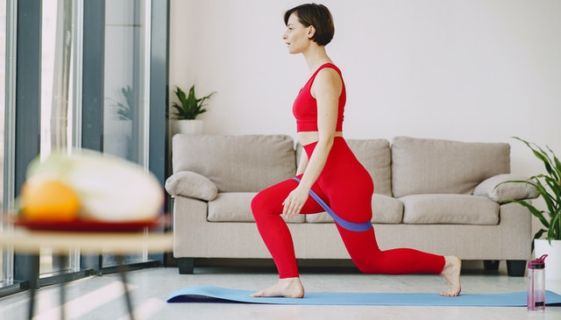You may have read the title of this post and wondered what could possibly be the connection between mindfulness and movement. The reason mindfulness is so important in movement is because as the mind begins to wander to that “to do list” or the “emails you have yet to answer”, your attention wanders away from your postural alignment and from your breath.
For instance, think about the last time you were sitting and working on your laptop, or getting lost in your smartphone scrolling on social media. What did your posture look like? Probably not great. Slouching puts a strain on our frame and compromises our ability to breathe properly.
So what exactly is Mindful Movement, and how can you incorporate it into your daily life? Let’s start by breaking down the name into its parts:
- We have mindful or mindfulness, which is the intentional practice of awareness of your present moment, with acceptance, and free of judgement.
- Then we have movement, which is simply the change in your body positioning over time.
You have probably heard of mindful movement practices like Yoga, Tai Chi, or Qigong, which all involve intentional and repetitive movements with emphasis on the breath and posture. But have you ever wondered why these ancient art forms of movement focus so much on breath and posture?
Health Benefits of Mindful Movements
Mindful movement practices like Tai Chi and Qigong have been associated with a decrease in anxiety, depression, blood pressure, and the stress hormone cortisol, along with increases in aerobic fitness, quality of life, bone health, balance, and even fall prevention. And if that alone isn’t enough to spark your curiosity, a recent study published in 2018 reported that Mindfulness during movement-based behaviors produced less momentary negative affect, a fancy term for negative emotions and their expressions. In basic English, this means that mindful movement can lead to a reduction in anger, fear, anxiety, sadness, and even depression. This is particularly relevant as we endure the current pandemic, since we are deprived of important social contact, our schedules are disrupted, and we endure a constant bombardment of negative and often frightening news.
So if a greater quality of life, a greater level of fitness, and a better mood with less anxiety isn’t enough to convince you to try mindful movement, there’s more!
Mindful Movement and Immunity
Mindfulness-based movement practices have also been shown to play a role in regulating the immune system by:
- decreasing markers of inflammation AND
- increasing virus-specific, cell mediated immunity, which in layman terms means that mindful movement can help lower systemic inflammation and boost your immune system when it is challenged (as with COVID-19).
Breaking Down Mindful Movement
All mindful movement practices share some common features. These are principles you can apply to any exercise or movement of choice.
The 5 components that make up Mindful Movement:
- Postural alignment or good posture with emphasis upon an upright or neutral spinal column;
- Muscular relaxation or the relaxing of muscles that are unnecessarily tense. To understand this, simply think about times you reflexively tense up. Perhaps next time you are focusing on a conversation with a friend or colleague, ask yourself if you are tensing up your forehead. Or, if you go outside into the cold, notice if your shoulders begin to creep up toward your ears, potentially leaving you with neck pain hours later;
- Deep, diaphragmatic breathing that is slow and controlled;
- Repetitive standardized movements that can be synchronized with your breath;
- Mindfulness, which prompts the person exercising to return awareness to the breath and body throughout the practice.
Developing a Daily Practice
- Do a quick body scan. A short body scan is a great way to begin tuning into your body’s physical and emotional state. It takes less than a minute and can even be done while you are lying in bed after you wake up. Starting at the top of your head, focus on each of your body parts to assess it for tension and relaxation. Start with your head, then move to your neck, shoulders, arms, chest, back, etc – making your way slowly down your body. This will help you figure out how your body is feeling that day – whether it is tight and sore, stressed and wound up, or loose and energized.
- Avoid rigid structure and all-or-nothing thinking. When you try to keep a strict exercise routine it can mean that, if it doesn’t happen, you end up feeling guilty which can cause more stress, which decreases the motivation to exercise the next time. Try not to berate yourself. Remember that tomorrow is a new day.
- Choose a form of movement or exercise that you enjoy. There is no reason to do exercise that you dislike! Try to figure out what brings you the most joy and what feels the best for your body. If you can’t think of any types of movement that you like doing, then it’s time for some exploration and trial and error. Look into different classes, whether it’s yoga, pilates, kickboxing, ballroom dancing, spin class, water aerobics, belly dancing, etc)… there are a ton of online streaming workouts or videos both paid and free. Or if you have been missing the sun and the outdoors… get outside and try hiking, biking, or walking while maintaining social distance in a safe way.
- Pay attention to how the movement makes you feel. Check in with yourself after you finish exercising – how does your body feel? Did your workout or movement that day leave you feeling energized? Do you feel stronger or have less pain? Focus on the internal, intrinsic benefits that you notice.
- Think about your “why”. Listen for that voice that pops up in your head when you think about exercise or movement. Are you exercising because you think you “should” or because you want to lose weight or because you want to burn calories? Notice when those “shoulds” pop-up and get curious about them. Then focus on finding a reason to move your body that has nothing to do with weight loss or calories. This could be for the way it makes you feel, for the physical health or mental benefits, or because you know it will help you get a good night’s sleep. Re-frame exercise as something that you have the opportunity to do to take care of your bod
Mindful Movements to Try at Home
Here are four gentle exercises that you can try at home to practice mindful movement.
Exercise 1: Alternating Superman
Exercise 2: Deadbugs
Exercise 3: Bird Dogs
Exercise 4: Split Squat Rotation



 Peter Pace
Peter Pace 

